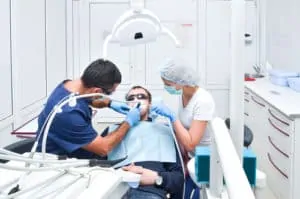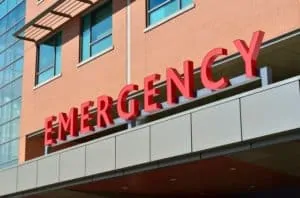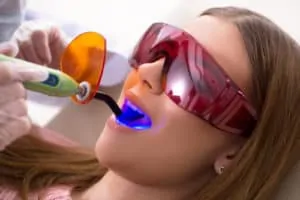Dental Emergency
It is that time again when kids eagerly collect bags full of candies during their door-to-door trick-or-treat adventures, and adults are bombarded with sugary sweets in the grocery aisles or haunted by all the treat-or-treat leftovers in the kitchen cabinet. It can only mean one thing – Halloween is here. While we fully appreciate the joy and significance of this tradition, it’s equally important to understand which candies pose the greatest threat to dental health. As your trusted dentist in Sparks, we’re here to shed some light on the worst offenders when it comes to cavity-causing candies.
Candy Corn
Whether you’re a fan or not, candy corn is always present during the autumn season. Despite its seemingly healthy name, this treat can spell trouble for teeth. Its sticky nature means it clings to teeth long after consumption, and its high sugar content provides a feast for those pesky sugar-loving bacteria that can wreak havoc on your teeth.
Taffy
This delightful confection comes in a plethora of mouthwatering flavors and vibrant colors, but don’t be fooled by its charm. Taffy not only contains a substantial sugar content but is also one of the stickiest treats around. This dual threat makes it detrimental to dental health as it can linger on teeth, and its stickiness can even harm dental restorations like fillings.
Lollipops
Lollipops and similar candies like jawbreakers or hard candies that require prolonged sucking sessions expose teeth to sugar for an extended period, which is a recipe for trouble. The longer the candy takes to consume, the more time sugar has to cling to teeth and induce damage.
Sour Candy
Sour candy not only delivers a hefty sugar dose but also adds an acidic punch to the mix. Acid can weaken tooth enamel, rendering teeth vulnerable to sugar-related damage. Excessive consumption of sour candies might necessitate a visit to your dentist in Sparks.
Popcorn
While popcorn may not be sweet, it’s a common find in trick-or-treat bags and an easy nightly snack. Popcorn’s sugar content is relatively low, but it conceals a hidden danger – those sneaky unpopped kernels. Biting down on them unexpectedly can result in tooth damage, leading to broken teeth or the harm of existing dental fillings.
You might not be able to entirely eliminate the temptation for these treats during Halloween, and that’s perfectly fine. What matters most is that you enjoy these indulgences in moderation and follow a daily dental hygiene routine that includes brushing and flossing. Additionally, make sure to see your dentist in Sparks at least every six months for checkups.
 What we eat not only affects our overall health but our oral health, too. It’s important to eat well-balanced meals, limit the sugary snacks, and choose fresh fruits and veggies whenever possible. But what exactly do you eat after dental treatment? You can’t chomp on a crunchy carrot very easily when your mouth is numb or sore, can you? Thankfully, your dentist in Sparks has compiled a list of easy things to eat after dental treatment.
What we eat not only affects our overall health but our oral health, too. It’s important to eat well-balanced meals, limit the sugary snacks, and choose fresh fruits and veggies whenever possible. But what exactly do you eat after dental treatment? You can’t chomp on a crunchy carrot very easily when your mouth is numb or sore, can you? Thankfully, your dentist in Sparks has compiled a list of easy things to eat after dental treatment.
Ice Cream
One of the best parts of getting dental treatment is that you have an excuse to eat ice cream, for every meal if you want to! Ice cream is a great option because not only is it super soft and doesn’t require chewing, it’s also really cold. This coldness can help you get relief if you’re dealing with some soreness and may help reduce swelling.
Yogurt
Another cool, comforting, and easy-to-eat treat that you can have after dental treatment is yogurt. Similarly to ice cream, yogurt doesn’t require you to chew and is also cold. Additionally, many yogurts contain mushed fruits that can give your body healthy nutrients. Just make sure to avoid eating yogurts with crunchy nuts or granola.
Soup
Don’t worry, not every food on this list is in the dairy family. Your dentist in Sparks knows that many patients may be lactose intolerant and will need additional, dairy-free options that are just as easy to eat. Soup is at the top of that list. From different flavored broths to the time-tested comforting chicken noodle, choosing a bowl of your favorite soup can provide your body with nutrients and help you feel full. Keep in mind that if you just had your wisdom teeth out, only eat soups that are warm and not really hot. Hot foods or drinks can slow down the healing process.
Mashed Potatoes
Another favorite go-to snack that’s easy to eat after dental treatment is mashed potatoes. Whether you prefer traditional mashed potatoes or sweet potatoes, as long as they’re cooked and mashed really well, you won’t have a problem eating them. Plus, sweet potatoes, in particular, have anti-inflammatory properties that can be great for oral and overall health.
Fish
Fish like tuna and salmon are not only soft, they’re also packed with healthy fats your body needs, making them an excellent choice for post-dental treatment. You can even pair well-cooked soft fish with some mashed potatoes and have a complete meal!
Following dental treatment, whether dental implant placement, oral surgery, root canal, or filling, you may not feel like eating. But it’s important to keep your body fueled, even if it’s by eating several small meals or snacks a day. Also, don’t forget to drink plenty of water to your mouth and your body hydrated.
If you need dental treatment or are just in need of a dentist in Sparks, give us a call to schedule an appointment. We’re always accepting new patients and are happy to help with anything you may need.

- Don’t Chew on Anything That’s Not Food. Our teeth are meant to help us chew and digest our food. But that doesn’t mean we should chew on non-food items. Nibbling on pen caps, pencils, fingernails, or other foreign objects can increase your risk of chipping or cracking a tooth, breaking a tooth, or injuring the soft tissues in your mouth. If it’s not food, keep it out of your mouth.
- Be Careful With the Food You Chew. So, even though we talked about how your teeth are specifically designed to help us chew our food, some foods can also increase the risk of tooth damage. Be careful when snacking on popcorn, hard fruits or vegetables, and even nuts. These foods are tough to chew, and if you catch a popcorn kernel or bite into a tough nut when you’re not expecting it, you can easily crack or chip a tooth or dental restoration. Lastly, avoid crunching on ice cubes. These frozen blocks are notorious for creating chips, cracks, and fractures in teeth.
- Choose Water. Water is the best beverage to both hydrate our bodies and to keep our oral health in tip-top shape. Other beverages such as soft drinks, fruit juices, and sports drinks may seem refreshing, but they are packed with sugar and acid. These two ingredients are a particularly bad combination for your teeth as they can both contribute to decay and weakened enamel.
- Avoid Tobacco. All forms of tobacco, including cigarettes, cigars, and chewing tobacco damage teeth and can not only increase the likelihood of experiencing a dental emergency, but they can also cause long-term, serious complications to both your oral health and overall health. Tobacco users tend to be at greater risk of oral cancer, gum disease, and even tooth loss.
- Limit Your Snack Times. Snacking can be good for you, but constantly snacking can be dangerous to your oral health. When we snack multiple times throughout the day, we’re continuously introducing food particles into our mouths. Why is this concerning to your dentist in Sparks? Well, more food particles in your mouth mean more bacteria. And a constant stream of foodstuffs regularly fuels the bacteria and keeps them active. As a result, the bacteria are constantly releasing an acidic byproduct, increasing your risk of decay and cavities.
Following the tips above won’t guarantee the prevention of a dental emergency, but they can help lower the risk and keep your mouth healthy. Of course, making sure to follow a strict oral hygiene routine at home is also important to protect your smile. Brushing twice a day, floss once a day, and see your dentist in Sparks regularly.*
If you think you may have a dental emergency, call your dentist to determine the best course of action for your specific needs.
*At the time of publishing, the ADA has recommended the postponement of all preventive dental appointments. Please check your local recommendations.

Why Do Fillings Fall Out?
Sometimes we put a lot of pressure on our teeth when we chew. This can cause a restoration to weaken and fall out. Also, as time wears on, your saliva can eat away at or loosen the bonding your Sparks dentist used to secure your filling. Sometimes the tooth that houses your restorative filling becomes subject to decay and deterioration. Other times fillings simply fall out because we bite down on something hard like a candy or popcorn kernel. Whatever the reason for your failing filling, be sure to have it fixed as soon as possible. Your tooth will be exposed to bacteria and unwanted food particles, causing sensitivity and even decay down the road.
What Should I Do Now?
First things first, give our Sparks dental office a call. If you’re unable to do that or get to the office right away, we have some tips to help you with your failed filling.
Tip #1 – If your filling didn’t fall out entirely or is loose, see if you can get it out — gently. If it stays in, there’s a chance you could swallow it or even choke.
Tip #2 – Your unfilled tooth is a welcoming environment for harmful bacteria to make a home and destroy your tooth. Be sure to brush gently and carefully. Rinse with water to make sure you’re removing any debris. Saltwater is great! Mix one cup of warm water, and one teaspoon of salt then rinse.
Tip #3 – Watch what you eat so that you don’t further damage your tooth. Avoid things that are sticky or hard. You don’t want anything getting stuck in your tooth or run the risk of breaking it when you bite. Keep foods simple and soft until you get a new filling.
Tip #4 – If you’re experiencing any sensitivity or pain, it’s usually OK to take over-the-counter pain medication to dull your discomfort. Try not to use any temporary dental cement to put your filling back in place. They tend to be messy, and you run the risk of further damaging your tooth.
What Will the Dentist Do?
One of the first things we’ll do when you come for a visit is to assess your damaged tooth thoroughly. We might even take some digital photos, too. We’ll use our training and cutting-edge technology to figure out what’s the best fit for your smile. If your tooth has not deteriorated or if it’s not severely decayed, we’ll be able to fix it with a new filling. Whatever treatment you need, take comfort in knowing you’re always in good hands at our dental office in Sparks.
We hope you learned a little something here today and that you’re able to get to the dentist soon. Failing or lost fillings are no fun! There’s no reason to panic though there’s a simple solution for every smile. We’re happy to be your dental partner and get your smile healthy and happy again!

The Most Common Dental Emergencies
The best thing you can do in the event of a dental emergency is to schedule an appointment with your dentist in Sparks as soon as possible. But there are some ways you can relieve discomfort and increase the chances of an easier treatment in the meantime.
- Knocked Out Tooth – Getting a tooth knocked out can certainly be scary. Acting quickly and calmly can actually help save your tooth, but there are some things you should know. After you find the tooth, only touch the crown and avoid contact with the roots. If you can, put the tooth back into the socket gently. If you can’t, place the tooth in a cup of milk or store it under the tongue with some spit and get to a dentist.
- Lost Filling – There are a number of things that can cause a filling to fall out, leaving a hole in your tooth. This can be painful as your tooth roots may now be exposed. The best thing to do is to fill the hole to protect those roots. Many pharmacies and grocery stores have dental cement you can buy and use to fill the hole. While this may help reduce pain, it is a temporary solution, and you should still see your dentist as soon as you can.
- Chipped or Broken Tooth – An injury or even something hard and crunchy can chip or break a tooth. Don’t panic. First, find any pieces of the tooth and rinse them off with water. If you’re bleeding, apply a piece of gauze and press. A cold compress can help with the pain and any swelling that may occur. There are many ways a tooth can be fixed, so again, schedule an appointment with your dentist.
Avoid a Problem
Even though nobody can really anticipate a dental emergency, you can help reduce your risk of one by making sure you see your dentist in Sparks every six months for regular checkups. These visits can help identify any potential problems before they become a painful surprise. You can also watch what you eat and make sure you wear a mouthguard when playing sports to further protect your smile.
The team at our Sparks dental office is here to help our patients and community stay healthy. Schedule an appointment with us today!

